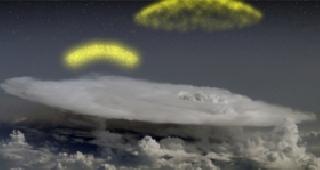
An artistic's creation. A NASA photo
WASHINGTON (PTI): For the first time, scientists have discovered that powerful thunderstorms on Earth can fling beams of antimatter into space.
The never-before-seen phenomenon, captured by NASA's orbiting Fermi gamma-ray observatory, has been billed as the most exciting discoveries in geoscience in a very long time.
Antimatter is a mirror image of normal matter with unusual properties – protons with negative charges, electrons with positive charges, and so on. It was created in equal abundance to normal matter at the beginning of the Universe, but was destroyed when it came in contact with normal matter.
"These signals are the first direct evidence that thunderstorms make antimatter particle beams," lead researcher Michael Briggs, of the University of Alabama in Huntsville, was quoted as saying by LiveScience.
"I think this is one of the most exciting discoveries in geoscience in a very long time," said Duke University's Steven Cummer, who was not involved in the research. "It seems like something straight out of science fiction."
Fermi is designed to monitor gamma rays, the highest-energy form of light. When a piece of antimatter strikes the observatory and collides with "normal" matter, both particles immediately annihilate and are transformed into gamma rays – which Fermi can detect.
In the new study, presented at the 217th meeting of the American Astronomical Society in Seattle recently, Fermi's Gamma-ray Burst Monitor (GBM) instrument picked up gamma rays with energies of 511,000 electron volts – a telltale sign that an electron has met its antimatter counterpart, a positron.
The gamma-ray detector spotted the antimatter signals while searching for terrestrial flashes of gamma rays. To date, scientists have identified 130 gamma-ray flashes from Earth since Fermi's launch in 2008, and four of them clearly show antimatter signatures, the researchers said.
"Even though Fermi couldn't see the storm, it nevertheless was magnetically connected to it," said Joseph Dwyer, of the Florida Institute of Technology.
"This (terrestrial gamma-ray flash) produced high-speed electrons and positrons, which then rode up Earth's magnetic field to strike the spacecraft."
The tops of thunderstorms harbour electric fields. Under the right conditions, scientists think, these fields can become strong enough that they drive an upward avalanche of electrons.
When these electrons are deflected by molecules in the atmosphere, they emit gamma rays. Some of these gamma rays pass near atomic nuclei, in the process transforming into an electron and a positron, researchers said. It's these particles that reach Fermi's orbit.
The revelation that thunderstorms can produce antimatter follows closely on the heels of the discovery that lightning can emit X-rays and gamma rays, researchers said.
"Just a year or so ago, it wasn't at all obvious that something like this should happen," Dwyer said.
Earth is likely not the only planet that boasts antimatter-generating storms, researchers said.
"There's every reason to think the same processes are happening on other planets, such as Jupiter and Saturn," Dwyer added.
 Previous Article
Previous Article Next Article
Next Article













The Indian Air Force, in its flight trials evaluation report submitted before the Defence Ministry l..
view articleAn insight into the Medium Multi-Role Combat Aircraft competition...
view articleSky enthusiasts can now spot the International Space Station (ISS) commanded by Indian-American astr..
view article